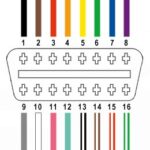The OBD-II code P0036 indicates a problem with the heater circuit in your car’s oxygen (O2) sensor, specifically Bank 1 Sensor 2. This sensor is crucial for your vehicle’s emissions system and fuel efficiency. Let’s break down what this code means, what causes it, and how you can troubleshoot it.
The P0036 code essentially tells you that the Engine Control Unit (ECU) has detected a malfunction in the heater circuit of the downstream oxygen sensor, which is located after the catalytic converter on Bank 1. Oxygen sensors with four wires typically have two circuits: one for sensing oxygen levels in the exhaust and another for heating the sensor. This heater is important because it brings the sensor up to its operating temperature quickly, allowing it to provide accurate readings to the ECU, especially during engine start-up and in colder conditions.
Several factors can trigger the P0036 code. The most common culprit is a faulty oxygen sensor itself. The heater element within the sensor can burn out or become damaged over time. However, other potential issues include:
- Wiring problems: Damaged, corroded, or loose wiring in the heater circuit can disrupt the electrical flow to the sensor.
- Connector issues: A poor connection at the sensor or ECU connector can also cause the code.
- ECU malfunction: In rare cases, a problem within the ECU itself could be misinterpreting sensor signals or incorrectly controlling the heater circuit.
Diagnosing a P0036 code typically involves a few key steps. First, a visual inspection of the wiring and connectors associated with the Bank 1 Sensor 2 oxygen sensor is crucial to check for any obvious damage. Next, using a multimeter, you can test the resistance of the heater circuit within the sensor itself and check for voltage at the connector to ensure the circuit is receiving power from the ECU. Comparing these readings to manufacturer specifications can help pinpoint whether the sensor or the wiring is at fault.
While diagnosing P0036, you might also encounter other codes. The original text mentions P0017, which relates to a camshaft timing issue. Although not directly related to P0036, if you are experiencing multiple engine codes, it’s important to address them systematically. P0017 suggests a discrepancy between the crankshaft and camshaft sensor signals, potentially due to sensor problems or issues with the Variable Valve Timing (VVT) system.
In many instances, resolving a P0036 code involves replacing the Bank 1 Sensor 2 oxygen sensor. This sensor is usually accessible from under the car, located downstream of the catalytic converter. Before replacing the sensor, ensure you have correctly identified Bank 1 and Sensor 2 for your specific vehicle, as configurations can vary.
In conclusion, OBD-II code P0036 signals a problem with the heater circuit of your downstream oxygen sensor. Troubleshooting involves checking the sensor, wiring, and connections. Replacing the oxygen sensor is often the most effective solution to resolve this issue and restore your vehicle’s emissions system to proper function.
